We all need a kitchen sponge holder. Here’s why.
Let’s talk about sponges and bacteria because these are the two classic problems we have when we are around the kitchen.
Usually, we clean our dishes with a sponge knowing that it could give our utensils and kitchen tools a good clean.
Think again.
Do you know that sponges can be a breeding ground for bacteria? If you are not careful in cleaning your sponges as well it might be more harmful to use them on your dishes.
A kitchen sponge is the number 1 cause of germs in the whole house. The moist absorber and micro-crevices that make a sponge a great cleaner are also a cozy hot spot for germs that can be difficult to disinfect.
Don’t ever think that cleaning your kitchen’s surfaces with a sponge can be a good idea.
Dirty sponges will only transfer bacteria from one item to the other.
Not yet concerned?
Think about this, 1 bacterium cell can divide in 10 to 20 minutes, and in 4 hours you could have 8,000 bacteria then imagine if it gets to 24 hours by then it will be millions of unnoticeable bacteria lurking in your kitchen.
But don’t lose hope!
You can prevent the spread of these germs from your kitchen by using sponge holders or a sponge sink caddy for your sponges!
Why Do You Need to Have a Sponge Holder for Your Sink?
Sponges are bacteria magnets. The proliferation of bacteria in your kitchen is the main reason why you need to have a sponge holder for your kitchen sink.
The number of bacteria it takes to make people sick ranges from 10 to millions and infections spread very quickly when germs are transferred from a contaminated item like a sponge to your utensils, hands, and to your body.
Secondly, sponge holders or sink caddies are good organizer for your sponge and dishcloth. It’s also a place to dry them when not in use.
The best sponge holder minimizes the transfer of germs by providing good ventilation for sponges to drain water and dry.
Although choosing sponge holders seems easy, there are still some considerations that need to be taken like its features and the benefits of convenience it will give to arrange the clutters in your sink.
Benefits of Having Dry Sponges and Dishcloths?
Sponges and dishcloths are cleaning accessories that we can do without. In fact, these are the cleaning tools that most Americans prefer and have been used for generations.
Having dry sponges and dishcloths prevents germs from accumulating and transferring them around the kitchen.
Here are some reasons why you need dish sponge dry:
1. Keeps your family away from illness-causing germs.
2. Helps limit bacteria from multiplying too quickly.
3. Keeping your dishcloths and sponges dry can prolong their usage.
4. Dry sponges and dishcloths can effectively collect grimes and wipes easily to make the countertop clean.
5. Prevents catching up mildew and foul smell making your kitchen safe from microbes.
Sponge caddy and dish sponge holder are great ways to make your sponges and dishcloths dry.
It’ll give them much ventilation and airflow to drain well and won’t smell.
However, to prevent germs to spread you need to clean your kitchen surfaces and your dishwashing tools as well.
Do’s and Don’ts in Cleaning Your Sponges and Dishcloths
Researchers found that high levels of contaminations in sponges make them unacceptable to use.
But why are we still using it as our major cleaning tool? While it has been around for generations, its function and cleaning benefits are apparent and instantly noticeable.
Abrasive sponges are good for getting out stuck-on food and non-abrasive sponges are great for wiping spills and cleaning dishes without a scratch. It is also a money-saver as it is cheap and disposable as well.
Cleaning your sponges and dishcloths is also imperative for your family’s health.
Here’s what you should do and not do in cleaning your sponges.
Do’s
1. Put them on your dishwasher on a dry cycle. (Avoid putting your sponge in the microwave because it’s a fire hazard).
2. Wash dish towels or dishcloths daily and frequently. Put it on the hot cycle of your washing machine and dry it on a high setting.
During summer, you can hang them dry outside so that they can be sanitized naturally in the sun.
3. In two or three weeks your sponges most likely harboring bacteria so it is safe to replace them regularly or if you notice an unpleasant smell at any point then it’s time to toss them out and replace them.
4. Wring your sponges and dishcloths completely and let dry every after use. Wash off well if there’s food or debris stuck on it.
5. Let them dry on a kitchen sponge holder or sponge caddy and avoid placing them under the sink or wet countertops as they will take longer to dry and bacteria will thrive.
Don’ts
1. Don’t be frugal when it comes to replacing your kitchen sponges when your family’s health is at stake.
Many of us keep sponges until they are dirty and smell bad. While others wait for them to fall apart before they could throw them out. Don’t wait months before you replace them.
2. Don’t use sponges to wipe on meat juices. Cleaning up spills can increase the chance of spreading foodborne pathogens. Instead, use paper towels or disinfectant wipes on meat juices.
3. Don’t forget the dishcloths. If not cared for properly, our dishcloths will also be a source of bacteria. Make sure that they are washed frequently and dried completely.
Features of Kitchen Sponge Holder and Sink Caddy
It is easy to assume that all kitchen sponge holders have the same level of performance, but a number of factors affect their functionality. It should have the right size and is made of high-grade materials.
It should also have proper ventilation holes to allow water to drain and have that stylish look that keeps up with your kitchen’s decors.
To learn more about the important features that a best kitchen sponge holder should have, keep reading as we give you the list.
1. Type
Kitchens sponge holders can accommodate one or two sponges while sink caddy can be able to take in brushes, soap, and dishwashing tools but both come in different types.
- Countertops sink caddies can be a good choice for small kitchen sinks and countertops that have limited space. However, you need to drain them regularly as they can easily fill up with water due to their small size.
- Tray sponge holder can hold up a single sponge. The best sponge holder should have a ribbed design or perforated bottom with a dish tray underneath to collect water and allow the sponge to dry properly.
- In-sink sponge holders and caddies are installed in the inside of the sink whether with suction cups, a ledge, or another water-resistant type of adhesive. They’re convenient to use because the water drips directly inside the sink and it clears out water sliding on the countertop.
- Two-in-one soap dispensers and sink caddies are usually designed to have a sponge tray above the soap dispenser. This is great for space-saving.
- Saddle-type holders and caddies are designed to be useful if you have a double sink. It rests in between the two dividers and provides storage for both sides.
2. Material
Most sink caddies and kitchen sponge holders are made of materials from plastics, silicone, and stainless steel.
- Plastics and silicone are used for budget-friendly sink caddies and sponge holders. They are easy to clean and the type of plastics used are the kind that doesn’t rust or minimize mold development. Translucent plastics are helpful to see the dirt and gunk built-up that settles at the bottom of the holder. However, they aren’t as durable as the ones made with stainless steel.
- Stainless steel sponge holders and sink caddies are more durable and long-lasting but are expensive compared to plastics and silicone versions. It can withstand moisture exposure because it’s rust and corrosion-resistant. Easy to clean and dishwasher safe.
- Aluminum chrome-plated materials are also used for sink caddy and sponge holders. They are a little cheaper than stainless steel and are durable, rust-proof, and corrosion-resistant as well.
3. Size/ capacity
The size and capacity of sponge holders vary but it usually is compact and won’t take much of the space in the sink. A standard sponge has a size of 4 inches long and 3inches wide so the smallest sponge holder will range around those dimensions.
Larger sink caddies and sponge holders that sit on the countertop or sink have room for multiple brushes and scrubbers.
4. Additional features
Some sink caddies put on these special features that provide added benefits.
- Suction cups are used to help in-sink holders to adhere to the sides of the sink better and can be moved and removed for cleaning.
- The perforated bottom allows for liquid to drain and additional perforated sides give better drainage.
- Some sponge holders have expandable brush holders that organize brushes with long handles without toppling over.
- Multiple compartments allow you to organize other cleaning tools easily and conveniently.
How to Install Each Type of Sponge Holders
Each type of sponge holder has a distinctive design for installing them. Choose the one that is best and convenient for you to install.
- In-sink suction type – This kitchen holder uses suction cups to adhere to the side of the sink. No drilling, no glue just clean the smooth surface of the sink and wet the suction cups, and stick the dishwashing sponge holder to the sink.
- Saddle-type sponge holders – If you have double sinks, it combines 2 pockets in one holder. This one doesn’t need any adhesive or suction cups. The inner layer of the sink caddy is soft and can be hung on a flat faucet or between the double sinks. Just hold the 2 pockets and hang them over the bar between your double sinks.
- Adhesive sponge holder and dishcloth hanger – It has waterproof strong transparent adhesive hooks that stick to the sink surface more durable and strong than suction cups. Just peel off the back cover and install the adhesives, stick it and press fully.
- Sponge rack for countertops- This has an anti-slip install at its base that can stay steadily at your countertops and protect countertops from scratches.
- Magnetic sponge holder – This uses magnets to install the sponge holder. To install clean the sink surface and just pop on the sponge holder. It will permanently and instantly pop on and pops out whenever you want to clean them.
Here’s a video on how to install The Crown Choice stainless steel sponge holder.
The best sponge holder
Do you ever need to organize your sponges and dishcloths? For a clutter-free sink, The Crown Choice stainless steel caddy is the way to go.
It has a premium rust-proof stainless steel sleek design that lets you organize your kitchen sink and countertop. Its compartment can fit 2 sponges and 1 dishcloth and has suction cups that do not fall off.
Installation is also a breeze. Make sure to install on a completely dry surface, no oil, grease, dirt. Remove all air bubbles and make sure there are no gaps around the edges of the adhesive.
Peel off the cover on the adhesive. Stick and press to the sink surface and Voila! You are now ready to enjoy your organized and clutter-free sink.
Give your sink a makeover and order your sink caddy and kitchen sponge holder now!
Frequently asked questions
What is a sponge holder?
The kitchen sponge holder is designed to provide ventilation that allows sponges to dry out to prevent mildew, molds, and germs to accumulate.
How do you store kitchen sponges?
You can use a kitchen sponge holder or sink caddy to store your kitchen sponges. It is more hygienic as it will allow your wet sponges and dishcloths to drain and be safe from the growth of any germs that can be hazardous to your health.
Where do you store your sponge holder?
Sponge holders can be installed either inside your sink or rest on your countertops. It also depends on the size of your sink and countertop if it can accommodate a sponge holder.
Sponge holders can also be installed in bathrooms and countertop style holders can be placed at the edged of the sink or tub while suction style holders can adhere to bathroom tiles.
How long should you use a kitchen sponge?
You need to replace your kitchen sponge frequently. If you see dirt on it and begin to smell bad then you’ll know that it’s time to replace them because bacteria build-up is starting. Don’t wait also for them to fall apart as it is not hygienic and may contaminate surfaces with germs if you use it continuously.
It’s not ideal to sanitize kitchen sponges by microwaving them daily after every use.
The kitchen sponge holder will give a clean and organized look on your sink and countertop but most of all it’ll provide you a sense of calm knowing that bacteria are minimized and won’t cause any health problems to your family.
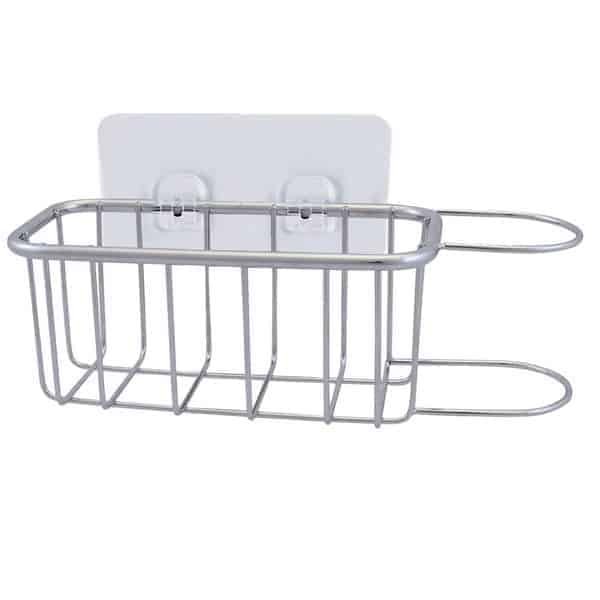
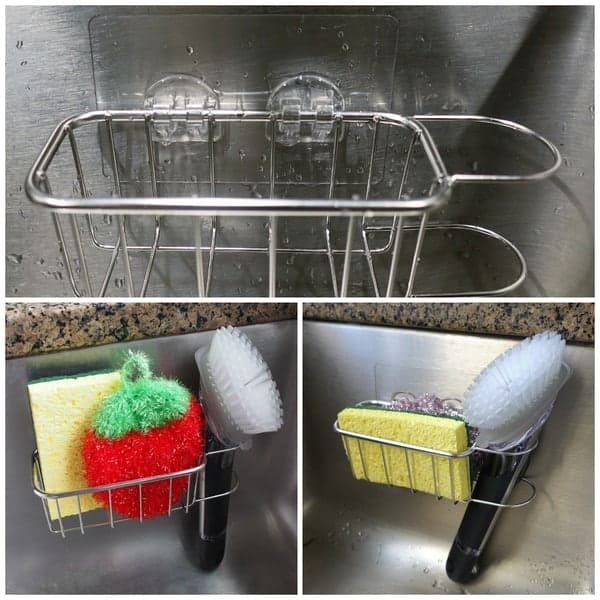
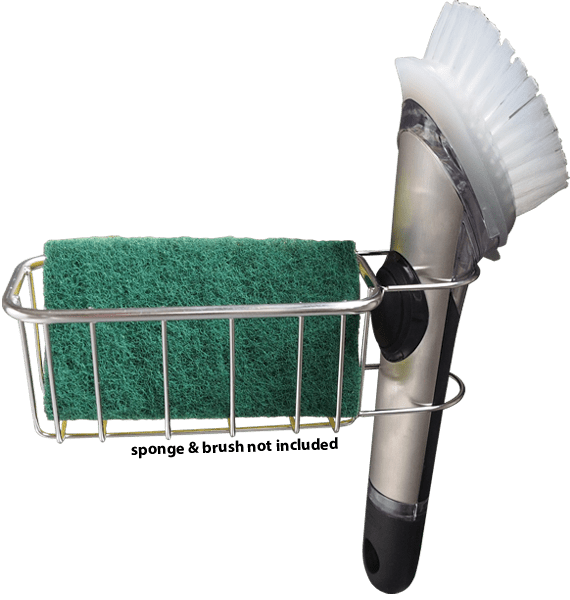

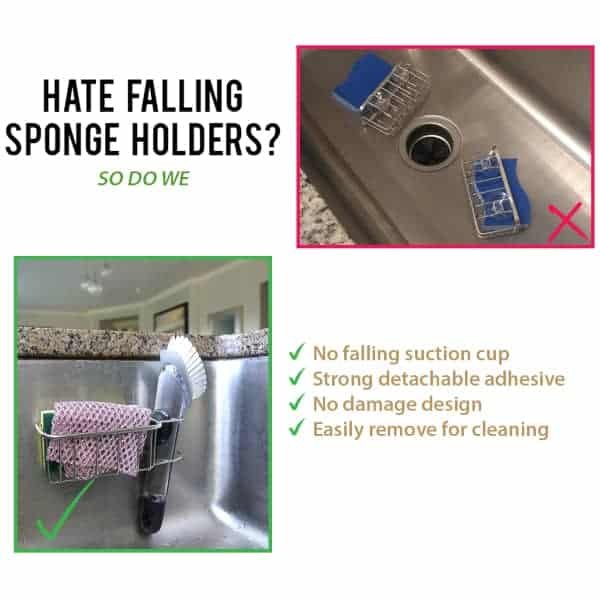

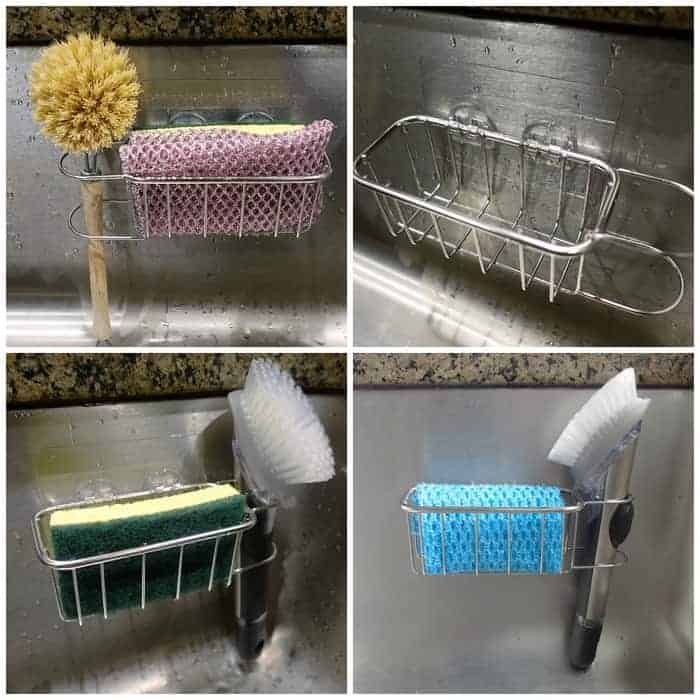
Easy insulation, only down side is I wish it could have been magnetic so that it would be more easily movable!
By Ally Gorban on January/17/2024
VERIFIED BUYER